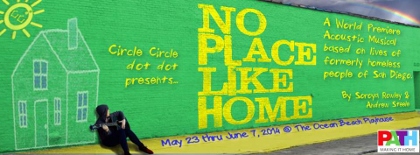COME HOME TO THE THEATER
Statistics vary, but there were approximately 700,000 homeless Americans in 2013. While the government reports that figures are less drastic since the 2007 economic downturn, it remains one of the most prevalent social issues of our time. We may witness homelessness, but for many it is difficult to truly empathize with this population or their issues, let alone understand how one can reach such dire situations of economic hardship.
Beginning May 23, Community-Based Theatre Company Circle Circle dot dot (CCdd) will present the tale of Daisy, a young, disabled woman who suddenly finds herself homeless and who must do whatever it takes to survive. But don’t expect a preachy diatribe from this exciting young company; expect a world premiere musical, No Place Like Home. Written by Soroya Rowley and Andrew Steele, and  directed by Rowley, CCdd’s first-ever acoustic musical production, an informative, entertaining, and touching perspective of another side of our humanity, will play at the Ocean Beach Playhouse through June 7, 2014.
directed by Rowley, CCdd’s first-ever acoustic musical production, an informative, entertaining, and touching perspective of another side of our humanity, will play at the Ocean Beach Playhouse through June 7, 2014.
“The character of Daisy is based on a real person,” Soroya Rowley tells Stage and Cinema in a recent interview. “CCdd Artistic Director Katherine Harroff had worked for The Old Globe Community Voices Program, a series of workshops dedicated to the creation and presentation of short plays by adult residents of San Diego County. Through this program, CCdd connected with an organization called PATH (People Assisting the Homeless), a family of agencies working together to end homelessness throughout Southern California.” One of PATH’s services is Connections Housing, which provides 223 housing units, a health center, and numerous social services all located in one downtown San Diego building. “To be a resident at PATH, you have to have a legal disability and have been chronically homeless for over a year.”
 Established in 2010, CCdd is both collaborative within the company and with outside artists who are willing to give additional perspective to a theatrical experience. Each performance is created completely from scratch by collecting stories and interviews with members of the community and then creating a script that is fleshed out in workshop rehearsals before ever hitting a stage. In keeping with their mission statement—“We take stories that are informative and insane, as well as thought-provoking and delusional in order to bridge gaps in communication and understanding of our fellow man”—the company met with a class of ten people who were either associated with Connections Housing or who were residents. “After interviewing 6 of the students,” Rowley said, “I chose someone who would be the inspiration for Daisy: A woman with cerebral palsy who at 19 was kicked out of her strict Mormon household for fighting with her stepmother over issues such as the way she dressed. Homeless for a year, ‘Daisy’ applied to PATH and was accepted.”
Established in 2010, CCdd is both collaborative within the company and with outside artists who are willing to give additional perspective to a theatrical experience. Each performance is created completely from scratch by collecting stories and interviews with members of the community and then creating a script that is fleshed out in workshop rehearsals before ever hitting a stage. In keeping with their mission statement—“We take stories that are informative and insane, as well as thought-provoking and delusional in order to bridge gaps in communication and understanding of our fellow man”—the company met with a class of ten people who were either associated with Connections Housing or who were residents. “After interviewing 6 of the students,” Rowley said, “I chose someone who would be the inspiration for Daisy: A woman with cerebral palsy who at 19 was kicked out of her strict Mormon household for fighting with her stepmother over issues such as the way she dressed. Homeless for a year, ‘Daisy’ applied to PATH and was accepted.”
As with most musicals, Rowley started with the book. “I wrote the dialogue first, and then I marked positions where I thought a song would be appropriate or where it would expand the emotional depth of what was going on with the character.” 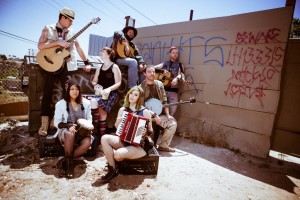 Rowley and co-composer Andrew Steele, having been in a rock band together for about four years, begin their songs with base chords and the key. Then, specific notes and lyrics are built upon that foundation with the cast. Once the show opens, however, the songs are set, not improvised.
Rowley and co-composer Andrew Steele, having been in a rock band together for about four years, begin their songs with base chords and the key. Then, specific notes and lyrics are built upon that foundation with the cast. Once the show opens, however, the songs are set, not improvised.
“Andrew and I have a base repertoire of songs that already fit into the themes of the play. Along with brand new songs are those previously written and then adapted for this show.” She adds that a couple of tunes are performed as written.
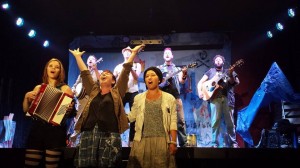 The style of the show is inspired by the Broadway musical Once, in which all the actors are on stage playing their own instruments—a group of people who get together as sort of a jam session to tell a story. “It’s a play-within-a-play,” Rowley says with kind assuredness. “So the people telling the story are a homeless group gathered together in an abandoned warehouse; the actors take on many roles as they tell the story of Daisy, which involves various locations—her home, the streets of San Diego, a truck stop, a trolley stop, even on a road trip to the Florida Keys.”
The style of the show is inspired by the Broadway musical Once, in which all the actors are on stage playing their own instruments—a group of people who get together as sort of a jam session to tell a story. “It’s a play-within-a-play,” Rowley says with kind assuredness. “So the people telling the story are a homeless group gathered together in an abandoned warehouse; the actors take on many roles as they tell the story of Daisy, which involves various locations—her home, the streets of San Diego, a truck stop, a trolley stop, even on a road trip to the Florida Keys.”
In the past, Soroya has acted and designed with this collective, which is comprised of artistic millennials, but this is her first foray into directing for CCdd. Yet she doesn’t sound overwhelmed in the least, even though the financial constraints 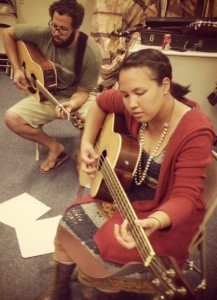 involved with renting a theater allow only one preview. “When entrenched in a piece it can be easy to lose perspective, especially since I’ve seen it so many times, but this is a very collaborative outfit. I have help from the company and welcome feedback from the actors. We even invite outside friends, family, and professionals to look at the piece and give their notes.”
involved with renting a theater allow only one preview. “When entrenched in a piece it can be easy to lose perspective, especially since I’ve seen it so many times, but this is a very collaborative outfit. I have help from the company and welcome feedback from the actors. We even invite outside friends, family, and professionals to look at the piece and give their notes.”
During her education, Rowley says she was very much taught to raise questions and not give answers, but CCdd is actively seeking answers by sharing ideas to make the world better. “Sometimes with artists, we get so much into our own head and our own world and our own emotion that a piece can feel masturbatory: It’s all about the artist. We’re about reaching out to the community so that they can connect with one another.”
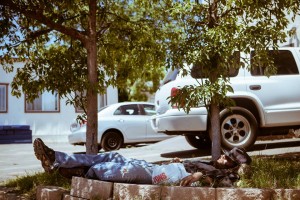 The fairly nascent company’s efforts on stage and off made them “a natural choice for La Jolla Playhouse’s 2014/2015 Resident Theatre Company,” wrote Playhouse Artistic Director Christopher Ashley, who spearheaded an annual appointment called the Resident Theatre Program. This provides a temporary home each year to one of the many local San Diego companies without a permanent venue. In addition to performance space, the Playhouse provides lighting and sound support and is available to offer marketing and development advice. Ashley explains LJP’s choice: “In just a few short years, CCdd has displayed a startling sense of ambition, adventure, and creativity, devising plays alongside local communities and branching out into site-based shows. That commitment to new work and new forms resonates with the Playhouse’s own mission.”
The fairly nascent company’s efforts on stage and off made them “a natural choice for La Jolla Playhouse’s 2014/2015 Resident Theatre Company,” wrote Playhouse Artistic Director Christopher Ashley, who spearheaded an annual appointment called the Resident Theatre Program. This provides a temporary home each year to one of the many local San Diego companies without a permanent venue. In addition to performance space, the Playhouse provides lighting and sound support and is available to offer marketing and development advice. Ashley explains LJP’s choice: “In just a few short years, CCdd has displayed a startling sense of ambition, adventure, and creativity, devising plays alongside local communities and branching out into site-based shows. That commitment to new work and new forms resonates with the Playhouse’s own mission.”
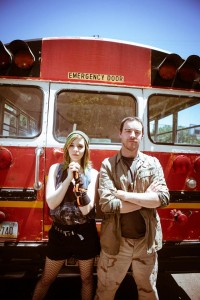 “Community” is a word that consistently comes up with CCdd for good reason. “We’re very inspired by the work of Brazilian theatre practitioner Augusto Boal [1931-2009], father of Theatre of the Oppressed,” says Rowley. Indeed, the banner of CCdd’s website displays a Boal quote: “We must all do theatre—to find out who we are, and to discover who we could become.” The early work of Boal was concerned with rebellion and upheaval, but his later work mostly concerned itself with creating harmony within society.
“Community” is a word that consistently comes up with CCdd for good reason. “We’re very inspired by the work of Brazilian theatre practitioner Augusto Boal [1931-2009], father of Theatre of the Oppressed,” says Rowley. Indeed, the banner of CCdd’s website displays a Boal quote: “We must all do theatre—to find out who we are, and to discover who we could become.” The early work of Boal was concerned with rebellion and upheaval, but his later work mostly concerned itself with creating harmony within society.
“We use a lot of his methods for connecting communities and getting them to share their stories in a responsible way,” continues Rowley. “Whatever group we’re working with, they have to give their blessing on any production that we do; they are invited to rehearsals and they need to feel well-represented before we take the next step forward—something we learned from Boal.”
 I wondered if Rowley considers CCdd Theatre for Social Change. “We don’t aggressively make that a part of our mission; it just kind of happens whether we want it to or not. We’re not seeking out groups which are necessarily oppressed.” Their play Ragnarok (2011) involved adults who do D&D-style live-action role-playing in a game where they dress up as Medieval or Fantasy characters. “This isn’t an oppressed group, but may be misunderstood. However, Deconstruction of a Drag Queen (2012), about drag culture and drag performances, centers on a group which is definitely marginalized; in that case, it’s Theatre for Social Change.” Changing the world may be one thing, but for Rowley the main goal of this non-Equity, volunteer company is to entertain as well as enlighten.
I wondered if Rowley considers CCdd Theatre for Social Change. “We don’t aggressively make that a part of our mission; it just kind of happens whether we want it to or not. We’re not seeking out groups which are necessarily oppressed.” Their play Ragnarok (2011) involved adults who do D&D-style live-action role-playing in a game where they dress up as Medieval or Fantasy characters. “This isn’t an oppressed group, but may be misunderstood. However, Deconstruction of a Drag Queen (2012), about drag culture and drag performances, centers on a group which is definitely marginalized; in that case, it’s Theatre for Social Change.” Changing the world may be one thing, but for Rowley the main goal of this non-Equity, volunteer company is to entertain as well as enlighten.
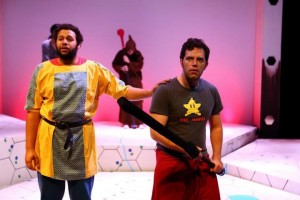 The company’s name is derived from the children’s playground song about immunizing oneself against the fictional childhood disease known as “cooties.” It begins, “Circle Circle dot dot, Now you got your cootie shot” (the circle and dot references a vaccination scar). “Our mission statement is all about bridging gaps of communication between all types of people, diverse cultures and subcultures,” Rowley explains. “When you don’t know about something or someone, they’re scary and weird and you assume they have cooties. Our mission is to help inform the community about various diverse groups of people in the world, so there’s more understanding and debate—and less cooties.”
The company’s name is derived from the children’s playground song about immunizing oneself against the fictional childhood disease known as “cooties.” It begins, “Circle Circle dot dot, Now you got your cootie shot” (the circle and dot references a vaccination scar). “Our mission statement is all about bridging gaps of communication between all types of people, diverse cultures and subcultures,” Rowley explains. “When you don’t know about something or someone, they’re scary and weird and you assume they have cooties. Our mission is to help inform the community about various diverse groups of people in the world, so there’s more understanding and debate—and less cooties.”
* * * * * * * * * *
promo, rehearsal, and previous production photos by Rich Soublet & The Company
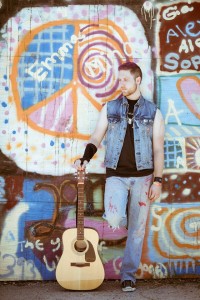 photo of Soroya Rowley by Aaron Rummely
photo of Soroya Rowley by Aaron Rummely
* * * * * * * * * *
No Place Like Home
Circle Circle dot dot
the cast: Katherine Harroff, Jon Huckaby,
Taylor Wycoff, Patrick Kelly,
Stacey Hardke, and Michael Nieto
Ocean Beach Playhouse
4944 Newport Avenue in Ocean Beach
Thurs – Sat at 8:00 pm, Sun at 4:00 pm
May 23rd – June 7th, 2014
for tickets ($20), visit www.circle2dot2.com
e-mail [email protected]
